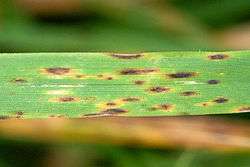Cochliobolus sativus
The fungus Cochliobolus sativus is the teleomorph (sexual stage) of Bipolaris sorokiniana (anamorph) which is the causal agent of a wide variety of cereal diseases. The pathogen can infect and cause disease on the root (where it is known as common root rot), leaf and stem, and head tissue. C.sativus is extremely rare in nature and thus it is the asexual or anamorphic stage which causes infections. The two most common diseases caused by B.sorokiniana are spot blotch and common root rot, mainly on wheat and barley crops.
| Cochliobolus sativus | |
|---|---|
 | |
| Symptoms on a wheat leaf | |
| Scientific classification | |
| Kingdom: | |
| Phylum: | |
| Subphylum: | |
| Class: | |
| Order: | |
| Family: | |
| Genus: | |
| Species: | C. sativus |
| Binomial name | |
| Cochliobolus sativus (S. Ito & Kurib.) Drechsler ex Dastur (1942) | |
| Synonyms | |
|
Bipolaris californica (Mackie & G.E. Paxton) Gornostaĭ (1978) | |
Identification
The mycelium of B.sorokiniana is usually deep olive-brown. New cultures produce abundant simple conidiophores, which may be single or clustered and measure 6–10 x 110–220 μm with septations. Conidia develop laterally from pores beneath each conidiophore septum. Conidia are olive-brown and ovate to oblong, with rounded ends and a prominent basal scar. They measure 15–28 x 40–120 μm and are 3- to 10-septate. Some may be slightly curved. Their walls are smooth and noticeably thickened at the septa.[1]
The sexual state (C. sativus), when formed in culture, is in the form of black, globose pseudothecia 300–400 μm in diameter, with erect beaks 50–200 μm long. Asci are clavate and measure 20–35 x 150–250 μm. Ascospores are hyaline, uniformly filamentous, and spirally flexed within asci. They measure 5–10 x 200–250 μm and are 4- to 10-septate.[1]
Host species
Agropyron cristatum1, Allium sp. 1, Alopecurus pratensis1, Aneurolepidium chinense1, Avena sativa1
Bromus inermis1, B. marginatus1, B. willdenowii1
Calluna vulgaris1, Chloris gayana1, Cicer arietinum1, Clinelymus dahuricus1, C. sibiricus1, Cynodon dactylon1, C. transvaalensis1
Dactylis glomerata1
Echinochloa crus-galli1, Elymus junceus1
Festuca sp. 1
Guzmania sp. 1
Hordeum brevisubulatum1, H. distichon1, H. sativum var. hexastichon1, H. vulgare1, H. vulgare var. hexastichon1
Lablab purpureus1, Linum usitatissimum1, Lolium multiflorum1
Pennisetum typhoides1
Roegneria semicostata1
Saccharum sp. 1, Secale cereale1, Setaria italica1, Sorghum sp. 1
Taraxacum kok-saghyz1, Trisetum aestivum1, Triticum aestivum1, T. secale1, T. turgidum subsp. durum, T. vulgare1’’
Zea mays1
Notes
Geographical distribution
Cochliobolus sativus has a world-wide distribution.
| Geographical distribution | |
|---|---|
| Africa | Kenya,1 Malawi,1 Sudan,1 South Africa, 1 Tanzania, 1 Zimbabwe1 |
| Australasia | Australia,1 China, 1 Korea, 1 India, 1 Indonesia, 1 New Zealand,1 Papua New Guinea,1 Taiwan, 1 Thailand1 |
| Central America | Cuba, 1 Mexico, 1 Nicaragua1 |
| Europe | Austria, 1 Belgium, 1 Czechoslovakia, 1 Denmark, 1 Germany, 1 Greece, 1 Hungary, 1 Italy, 1 Poland, 1 Scotland, 1 United Kingdom, 1 USSR |
| North America | Canada (Alberta, 1 Manitoba, 1 Saskatchewan1) US (Indiana, 1 Kansas, 1 Minnesota, 1 Montana, 1 New York, 1 North Dakota, 1 South Dakota, 1 Utah, 1 Virginia1) |
| South America | Argentina, 1 Brazil1 |
Notes
Main diseases
Common root rot (barley); Common root rot (wheat); spot blotch (barley); Spot blotch (wheat)
Spot blotch of wheat
This is most important disease in non-tradition wheat growing areas. The B. sorokiniana comes with Pyrenophora tritici-repentis and causes millions of tons of wheat loss each year. The symptoms are blotch as well as induced senescence due to premature chlorophyll losses Rosyara et al., 2007.
References
- Wiese, M.V. (1987). Compendium of wheat diseases. American Phytopathological Society. pp. 124 pp.Ascus